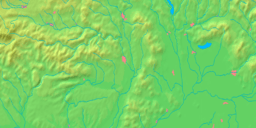Sobrance
| Sobrance | ||
| Town | ||
|
||
| Country | Slovakia | |
|---|---|---|
| Region | Košice | |
| District | Sobrance | |
| Tourism region | Dolný Zemplín | |
| Elevation | 122 m (400 ft) | |
| Coordinates | SK 48°44′37″N 22°10′51″E / 48.74361°N 22.18083°ECoordinates: SK 48°44′37″N 22°10′51″E / 48.74361°N 22.18083°E | |
| Area | 10.680 km2 (4.124 sq mi) | |
| Population | 6,274 (31 December 2008) | |
| Density | 587/km2 (1,520/sq mi) | |
| First mentioned | 1344 | |
| Mayor | Štefan Staško | |
| Timezone | CET (UTC+1) | |
| - summer (DST) | CEST (UTC+2) | |
| Postal code | 073 01 | |
| Phone prefix | 421-56 | |
| Car plate | SO | |
  Location of Sobrance within Slovakia | ||
  Location of Sobrance in the Košice Region | ||
| Statistics: MOŠ/MIS | ||
| Website: http://www.sobrance.sk | ||
Sobrance (German: Sobranz, Hungarian: Szobránc) is a town in Košice Region, Slovakia, around 15 kilometres (9 miles) from Uzhhorod, Ukraine, and 22 kilometres (14 miles) east of Michalovce. Located in the Eastern Slovak Lowland not far from the Vihorlat Mountains, it is the easternmost town in Slovakia.
History
The first written record comes from 1344, when Sobrance gained town status in 1351. In 1910, the town had 1216 inhabitants, 538 Hungarians and 577 Slovaks. Before First World War the town was part of Austria-Hungary. After the First World War as result of the Treaty of Trianon town became part of newly founded Czechoslovakia and became the capital city of its own district. During the Slovak-Hungarian War Sobrance became the part of Hungary. During Second World War town was heavily damaged and after the war town became part of Czechoslovakia again, but did not immediately regain its district status. Since the Dissolution of Czechoslovakia, Sobrance has been part of Slovakia. It regained its district town status in 1996.
The first reference to Jewish residents appears in the May 15, 1739 Jewish Conscription of Ung County which recorded only one Jewish family. The head of the household was Marko Joseffovics (Marko the son of Josef), a distiller of whisky (palinka, slivovica or vodka). By July 1746 there were two Jewish families—Marko Joseffovics and Hersko Abrahamovics (Hersko the son of Abraham). The Chevra Kadisha or burial society was founded in about 1780, a time when the Jewish population of northeastern Hungary began to grow due to migrations from Galicia. Their percentage stood at 24.3% in 1910. The synagogue, which was still standing in 1929, was built in about 1800.[1] Following the Nazi invasion of Hungary on May 17, 1944 all of the Jews living in Sobrance were deported to Auschwitz concentration camp as part of the Final Solution where most were murdered upon arrival.[2] The property and belongings that were left behind were looted in a thoroughly organized act by the local non-Jewish population of Sobrance soon after the deportation.[3]

Sights
To the north of the town is Sobranecké kúpele, once a popular spa before the First World War. Today it is totally abandoned.
A Guitar museum is located in the town. The collection includes more than 200 guitars mainly from the period of 1947–1980. Perhaps the most valuable guitar is a Resonet Grazioso/Futurama from early in the career of George Harrison.
A Byzantine Catholic Church of the Holy Seven Slavonic Saints (Sedmočislenici) was built in the town. It is a modern church building based on traditional Byzantine architecture models.
Demographics
According to the 2001 census, the town had 6,262 inhabitants. 95.37% of inhabitants were Slovaks, 0.91% Roma, 0.51% Czechs and 0.37% Ukrainian.[4] The religious makeup was 51.09% Roman Catholics, 33.93% Greek Catholics, 3.59% people with no religious affiliation and 3.37% Orthodox.[4]
International relations
Twin towns — Sister cities
Sobrance is twinned with:
-
 Lubaczów, Poland
Lubaczów, Poland

